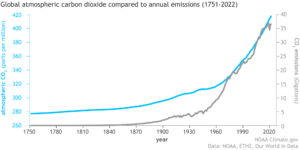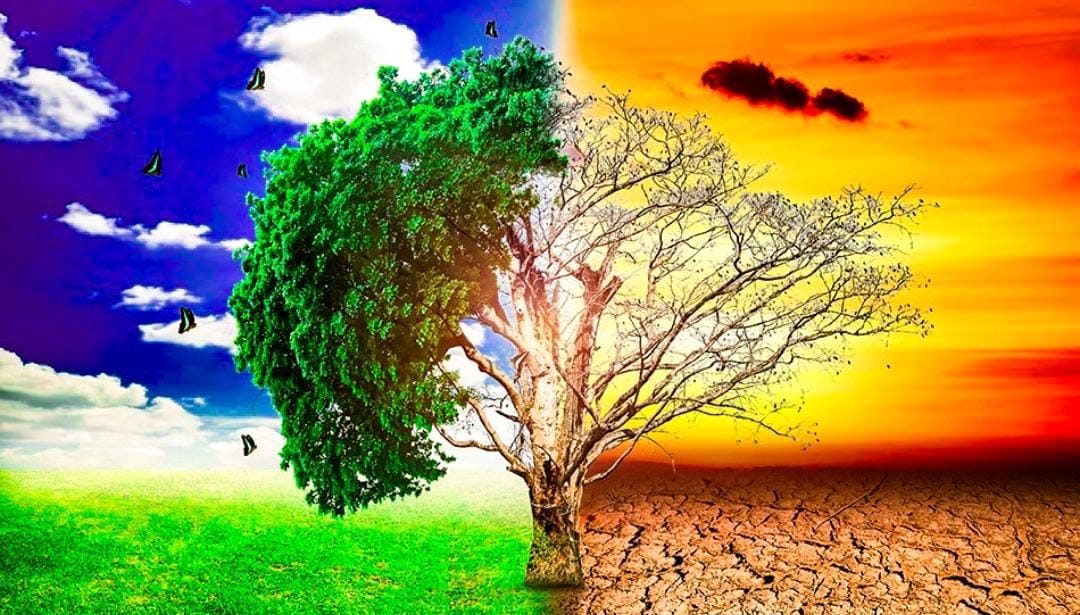Abstract:
The global climate keeps changing due to the impact of greenhouse gases that are released into the atmosphere. Mitigating climate change means minimizing the flow of heat-trapping greenhouse gases into the atmosphere. This involves curbing such gases from main sources such as power plants, factories, motor vehicles, and farms. Forests, oceans, and soil too absorb and store these dangerous gases and thus play an important role in the solution. Reducing and avoiding emissions require reshaping everything we do from how we power our economy and grow our food to how we travel and live as well as the products that we consume. It is a major issue being felt locally and globally.
Climate change is affecting both natural and urban environments with serious consequences on their balance and ecosystems. It is the major cause of large-scale human migration. Natural and anthropogenic activities such as volcanic eruptions, tectonic plate movement, deforestation, greenhouse gas emissions, and air pollution are the main drivers that cause global warming. These activities increase the air temperature, causing changes to rainfall patterns and the occurrence of extreme weather-related events.
Keywords: Mitigation strategies; Climate change; Global warming; Greenhouse gases; Weather
Introduction:
The climate change phenomenon has become a global challenge affecting human activities in multiple ways. Intense and extreme weather-related catastrophes such as floods, cyclones, tornadoes, forest fires, more frequent torrential rain fall, prolonged droughts, heatwaves, warmer and more humid winters with less snowfall and high wind speeds continue to be experienced in various parts of the world. This is attributed to increasing atmospheric temperature due to emissions of greenhouse gases from burning fossil fuels, clearing forests, and raising livestock. Climate change affects different ecosystems and the services they provide to society. For example, increased infections by insects and fungi, tree mortality, high stress on the components of forest ecosystems, deteriorating and downsizing of biodiversity that affects production, supply and other functions which forests provide to society and rising of sea level which also endanger life and properties in coastal areas that are attractive to human settlement.
The economic costs and social consequences of climate change disproportionately affect the vulnerable and people experiencing poverty often. This is because three quarters of the people living in poverty line rely heavily on ecosystem services or nature based activities, particularly farming which is negatively impacted by climate change and resulting in decreasing agricultural yields. Also, much of the impact of climate change, which results in chronic water shortages, rising sea levels, flooding, mass population displacement and damage to productive infrastructure, affect the vulnerable and those impacted by inequalities. The plight of the vulnerable is worsened by erratic weather, limited access to water sources and increased competition for resources to the level of life and death.
Under the Covid-19 pandemic where millions were plunged into poverty in 2020, climate change is expected to worsen the situation if the pandemic is not mitigated. In this regard, managing the ecosystem including agriculture, soil, and water resources is paramount in mitigating the adverse effects of climate change on the vulnerable. There has been considerable attention on responses to climate change at the global, national, and domestic levels, which has resulted in two distinct responses. The first relates to measures aimed at slowing down and moderating the pace of climate change which implies cutting down or lessening greenhouse gas emissions into the atmosphere, termed mitigation measures. The second response to the impacts of climate change is described as adaptation. It includes measures that focus on the capacities of individuals, communities, and nations to handle the effects of changed conditions and take advantage of the opportunities they offer. The challenges include securing the climate financing required for adaptation and mitigation plans to transition of developing economies, political will and commitment to policy implementation and knowledge gaps which require increased cooperation between scientists, researchers, businesses, and public authorities. Reducing greenhouse gas emissions is crucial to tackling the impacts of climate change, especially methane gas emissions which are seen as a priority area for action by the European Union (EU). Methane is the main component of natural gas and it is extremely effective at trapping heat, much more than carbon dioxide (CO2). People generally link global warming with CO2, as half of the increase in global temperature since industrial levels are due to higher methane or CH4 concentrations in the atmosphere. The methane concentrations are responsible for about half of the increase in global temperature and the associated climate impacts. The second reason is that due to the rapidly increasing methane concentrations, the global warming effect of methane has increased markedly in the past years relative to CO2. And the third reason is that when countries report greenhouse gases or do climate mitigation analysis, they use the agreed global warming potentials over a period of a century. Though methane lasts in the atmosphere for around 12 years, within that shorter period of time, its actual global warming potential is much higher. The current methane emissions are three times worse for climate change in the short term. Also reducing them more rapidly would be three times more effective.
Landfill gas recovery from waste or biogas produced from agricultural manure can be used directly for energy and/or upgraded to biomethane to produce thermal energy and electricity. Bio gas in particular has a big potential to reduce methane emissions in the agriculture sector. One can also use the recovered methane in the production of hydrogen, although we should favour green hydrogen produced from renewable energy sources, such as wind and solar power, mainly because it results in zero emissions. Reducing methane emissions improve both climate change mitigation and better air quality, because of the synergies in the reduction of greenhouse gases and air pollutants.
Also, the methane that is recovered can partly replace the use of imported natural gas, and hence improve energy security to some degree. We need to think ‘circular’ because it reduces greenhouse gas emissions, improves air quality, and reduces our energy dependency. Maybe first to clarify that methane emissions originate from both natural sources and human activity. The natural methane comes from wetlands, termites, oceans, hydrates (CH4 trapped in water at low temperatures and under high pressure), forests, wildfires, wild animals, permafrost, and geological sources. The key methane sources worldwide are also those found in Europe, though their importance vary. Methane is usually a larger source of greenhouse gas emissions in countries with larger agriculture sectors (livestock mainly) or with a lack of adequate waste management systems or having poorly laid pipeline infrastructure to carry natural gas.
In the EU, 12% of total greenhouse gas emissions in 2020 were of methane, and of this, half of the emissions came from the agriculture sector. The trends have been positive in the past 30 years since 1990, with methane emissions down substantially in energy supply, waste management, and until recently in the agricultural sector. Reduced emissions reflect a decrease in agricultural livestock, lower levels of coal mining; an improved oil and gas pipeline network; less waste disposal on land, and an increase in recycling, composting, landfill gas recovery, and waste incineration to generate thermal energy and electricity. Though past performances have been positive, further reductions of methane emissions become increasingly difficult; though not impossible in the agriculture sector. In addition to the advancements and implementation of methane reducing practices and technologies, the food choices made by consumers could also contribute to lower methane emissions.
Discussion:
The difference between climate change mitigation and adaptation is both climate change mitigation and climate change adaptation are important in curbing the effects of global warming. Mitigation efforts can reduce the rate of global atmospheric temperature rise and eventually even reverse it. However, this will take many decades, which means adaptation is needed to protect nature, people, and livelihoods from the impacts of global climate change. Heatwaves, droughts, floods, and coastal erosion are all happening now. Hence, adaptation measures must be deployed to improve the resilience of impacted areas and to prepare for unforeseen future impacts. Responding to climate change involves two possible approaches: reducing and stabilizing the levels of heat-trapping greenhouse gases in the atmosphere (i.e., mitigation) or adapting to the climate change already in the pipeline (i.e., adaptation).
The first approach, emission-reducing measures from sources, includes improving energy efficiency to reduce the fuel needed to produce a given output and replacing fossil fuel sources (oil, gas, coal) with renewable energy alternatives (such as wind, solar, and hydropower). In recent years, the cost of wind and solar electricity generation has rapidly reduced, making these often the cheapest source of electricity generation where the wind speeds or insolation levels are in suitable level.
The next major mitigation challenge is the decarbonization of heat and transport, with electrification and hydrogen presenting alternatives to fossil fuels. Embedding storage in distribution networks at the end increases the utility of these low-carbon transition routes while reducing the impact of offshore wind intermittency.
The second approach to mitigate climate change is to increase the effectiveness of sinks. Popular measures include tree planting, increasing vegetation cover, and improving soil absorption of CO2. Reversing the degradation of sinks for example, through acting to reduce deforestation is also crucially important, both for mitigation and for biodiversity conservation. Technologies such as carbon capture utilization and storage are also being deployed at a pilot scale, including direct capture of CO2 from the atmosphere for conversion and storage in geological formations, or for use in the production of fuels, chemicals, building materials, and other products containing CO2. Carbon dioxide concentrations are rising mostly because of the fossil fuels that people burn for energy. Fossil fuels like coal and oil contain carbon that plants pulled out of the atmosphere through photosynthesis over many millions of years; we are returning that carbon to the atmosphere in just a few hundred (Figure 1). Such technologies involve large investments in demonstration projects to realize their potential.

Figure 1: The amount of carbon dioxide in the atmosphere (blue line) has increased along with human emissions (gray line) since the start of the Industrial Revolution in 1750. Emissions rose slowly to about 5 billion tons per year in the mid-20th century before skyrocketing to more than 35 billion tons per year by the end of the century.
There are many steps that individuals, businesses, governments, and civil society can take to help tackle climate change. Successful action to adapt to climate change is often dependent on the capacity it has to engage the societies it impacts. Top-down policies alone are not enough. Actively communicating with stakeholders and giving them a platform to speak is critical to promoting long-lasting behavioral change, sharing experiences, and understanding the social and cultural impact of climate action. Minimum Energy Performance Standards laws enforce and guide new energy-efficient products or appliances. Look for labels and information that would help you in choosing devices that offer greater energy-saving features. Taking advantage of the availability of renewable energy sources is also a step to defeat the effects that cause climate change. Therefore, greater uptake of renewable energy is needed to reduce and eventually remove the need for fossil fuels.
At home, using a renewable energy source could involve by installing solar panels on your roof, or simply switching to a renewable energy source from your lone power supplier. The more people choose renewable energy supply options, the more it attracts suppliers who step into investing. Consider heat decarbonization to improve efficiency. The first step in heat decarbonization is to insulate the building fabric and seal up draughts, so heat does not go wasted. Then replace boilers where practicable with heat pumps that are ultra-efficient and powered by renewable electricity. Reducing water and food waste is important because it reduces greenhouse gas emissions through our food choices.
Therefore, consume less meat and more plant-based foods. Reduce food waste. Bring your own take-home container to a restaurant to take home leftovers and avoid using a disposable container. One-time-use containers waste resources and energy, leading to greenhouse gas emissions. Compost leftover food instead sending it to a landfill where it releases methane when it decomposes. Less water needs to be pumped, heated, and treated. You can also mitigate emissions by reducing food waste, eating less meat, and using local supplies rather than transporting food from long distances. Energy consumption act as a main role here, using renewable energy the most direct and long-term cost savings approach is to install solar panels at your home. If you are unable to do that, you can take part in a community solar group by purchasing a panel or subscribing to a solar farm. Sign up for an electricity supplier that uses wind energy and other renewables. Advocate your community to install more renewable energy infrastructure and illuminate your home and power your transportation. If our utility companies switch to low-carbon sources for generating electricity, then we all can reduce greenhouse gas emissions by running various systems with electricity instead of fossil fuels. Traveling less especially flying and switching to fuel and carbon-efficient options like public transportation or electric vehicles all reduce emissions and thereby save you money. If you are unable to switch over from your old petroleum-powered vehicle to an electric vehicle, then try to drive it in a more fuel-efficient manner and take a shorter distance drive, drive less frequently. Also at home, switch to a heat pump for heating and/or cooling your home. Heat pumps run on electricity instead of burning fossil fuels, and they are highly energy efficient. The upfront installation costs could be high, but heat pumps could save you a lot of money in the long run. If you can, drive an electric car. In addition to avoiding emissions, you’ll be using a vehicle that is much more energy efficient.
Most countries have implemented a variety of climate change-related legislation over recent decades that benefit people and the planet. They are;
- Transportation policies that encourage switching to low-carbon alternatives.
- Grants and loans used to lower the risk of low carbon transition, improve the viability of low carbon technologies, and support innovation.
- Carbon or energy taxes to help price emissions.
- Subsidies for fossil fuels and other environmentally damaging activities can be removed and replaced by penalties.
- Emissions trading schemes with caps and tradable permits offer a route to cost-effectively reduce emissions.
Your actions do matter; every little contribution, and they may be a small, positive outcome of many individual actions can accumulate to a large, positive outcome. Individuals who come together to form groups can create a lot of change on a community level, encouraging the adoption of renewable energy and changes in infrastructure to promote energy efficiency. Even a small group of people can have a big impact.
Rahman MD Shahinur
(Rahman MD Shahinur is a master’s student at Zhejiang University of Science and Technology majoring in Intelligent Manufacturing and Control Engineering from Bangladesh. He is a self-motivated student, participating in volunteering and social activities at the university. He has successfully completed his bachelor’s degree in Electrical Engineering and Automation at Chongqing University of Technology in China. He is writing his own article on different aspects.)
References:
- https://www.climate.gov/
- https://www.priweb.org/
- https://www.icf.com/
- https://www.sciencedirect.com/science/article/pii/S2405844023026981
- https://www.eea.europa.eu/
- https://www.ipcc.ch/




